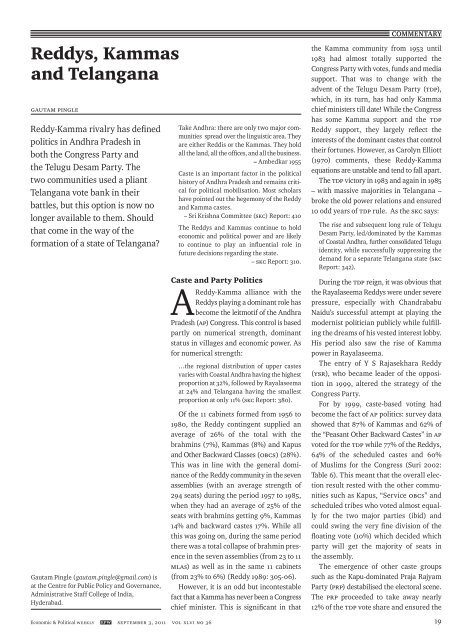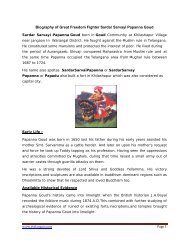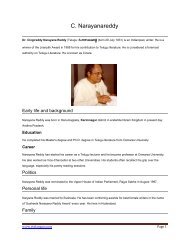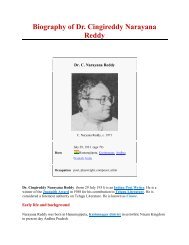Reddys, Kammas and Telangana
Reddys, Kammas and Telangana
Reddys, Kammas and Telangana
Create successful ePaper yourself
Turn your PDF publications into a flip-book with our unique Google optimized e-Paper software.
<strong>Reddys</strong>, <strong>Kammas</strong><br />
<strong>and</strong> <strong>Telangana</strong><br />
Gautam Pingle<br />
Reddy-Kamma rivalry has defined<br />
politics in Andhra Pradesh in<br />
both the Congress Party <strong>and</strong><br />
the Telugu Desam Party. The<br />
two communities used a pliant<br />
<strong>Telangana</strong> vote bank in their<br />
battles, but this option is now no<br />
longer available to them. Should<br />
that come in the way of the<br />
formation of a state of <strong>Telangana</strong>?<br />
Gautam Pingle (gautam.pingle@gmail.com) is<br />
at the Centre for Public Policy <strong>and</strong> Governance,<br />
Administrative Staff College of India,<br />
Hyderabad.<br />
Take Andhra: there are only two major communities<br />
spread over the linguistic area. They<br />
are either Reddis or the <strong>Kammas</strong>. They hold<br />
all the l<strong>and</strong>, all the offices, <strong>and</strong> all the business.<br />
– Ambedkar 1955<br />
Caste is an important factor in the political<br />
history of Andhra Pradesh <strong>and</strong> remains critical<br />
for political mobilisation. Most scholars<br />
have pointed out the hegemony of the Reddy<br />
<strong>and</strong> Kamma castes.<br />
– Sri Krishna Committee (SKC) Report: 410<br />
The <strong>Reddys</strong> <strong>and</strong> <strong>Kammas</strong> continue to hold<br />
economic <strong>and</strong> political power <strong>and</strong> are likely<br />
to continue to play an influential role in<br />
future decisions regarding the state.<br />
– SKC Report: 310.<br />
Caste <strong>and</strong> Party Politics<br />
A<br />
Reddy-Kamma alliance with the<br />
<strong>Reddys</strong> playing a dominant role has<br />
bec0me the leitmotif of the Andhra<br />
Pradesh (AP) Congress. This control is based<br />
partly on numerical strength, dominant<br />
status in villages <strong>and</strong> economic power. As<br />
for numerical strength:<br />
…the regional distribution of upper castes<br />
varies with Coastal Andhra having the highest<br />
proportion at 32%, followed by Rayalaseema<br />
at 24% <strong>and</strong> <strong>Telangana</strong> having the smallest<br />
proportion at only 11% (SKC Report: 380).<br />
Of the 11 cabinets formed from 1956 to<br />
1980, the Reddy contingent supplied an<br />
average of 26% of the total with the<br />
brahmins (7%), <strong>Kammas</strong> (8%) <strong>and</strong> Kapus<br />
<strong>and</strong> Other Backward Classes (OBCs) (28%).<br />
This was in line with the general dominance<br />
of the Reddy community in the seven<br />
assemblies (with an average strength of<br />
294 seats) during the period 1957 to 1985,<br />
when they had an average of 25% of the<br />
seats with brahmins getting 9%, <strong>Kammas</strong><br />
14% <strong>and</strong> backward castes 17%. While all<br />
this was going on, during the same period<br />
there was a total collapse of brahmin presence<br />
in the seven assemblies (from 23 to 11<br />
MLAs) as well as in the same 11 cabinets<br />
(from 23% to 6%) (Reddy 1989: 305-06).<br />
However, it is an odd but incontestable<br />
fact that a Kamma has never been a Congress<br />
chief minister. This is significant in that<br />
COMMENTARY<br />
the Kamma community from 1953 until<br />
1983 had almost totally supported the<br />
Congress Party with votes, funds <strong>and</strong> media<br />
support. That was to change with the<br />
advent of the Telugu Desam Party (TDP),<br />
which, in its turn, has had only Kamma<br />
chief ministers till date! While the Congress<br />
has some Kamma support <strong>and</strong> the TDP<br />
Reddy support, they largely reflect the<br />
interests of the dominant castes that control<br />
their fortunes. However, as Carolyn Elliott<br />
(1970) comments, these Reddy-Kamma<br />
equations are unstable <strong>and</strong> tend to fall apart.<br />
The TDP victory in 1983 <strong>and</strong> again in 1985<br />
– with massive majorities in <strong>Telangana</strong> –<br />
broke the old power relations <strong>and</strong> ensured<br />
10 odd years of TDP rule. As the SKC says:<br />
The rise <strong>and</strong> subsequent long rule of Telugu<br />
Desam Party, led/dominated by the <strong>Kammas</strong><br />
of Coastal Andhra, further consolidated Telugu<br />
identity, while successfully suppressing the<br />
dem<strong>and</strong> for a separate <strong>Telangana</strong> state (SKC<br />
Report: 342).<br />
During the TDP reign, it was obvious that<br />
the Rayalaseema <strong>Reddys</strong> were under severe<br />
pressure, especially with Ch<strong>and</strong>rababu<br />
Naidu’s successful attempt at playing the<br />
modernist politician publicly while fulfilling<br />
the dreams of his vested interest lobby.<br />
His period also saw the rise of Kamma<br />
power in Rayalaseema.<br />
The entry of Y S Rajasekhara Reddy<br />
(YSR), who became leader of the opposition<br />
in 1999, altered the strategy of the<br />
Congress Party.<br />
For by 1999, caste-based voting had<br />
become the fact of AP politics: survey data<br />
showed that 87% of <strong>Kammas</strong> <strong>and</strong> 62% of<br />
the “Peasant Other Backward Castes” in AP<br />
voted for the TDP while 77% of the <strong>Reddys</strong>,<br />
64% of the scheduled castes <strong>and</strong> 60%<br />
of Muslims for the Congress (Suri 2002:<br />
Table 6). This meant that the overall election<br />
result rested with the other communities<br />
such as Kapus, “Service OBCs” <strong>and</strong><br />
scheduled tribes who voted almost equally<br />
for the two major parties (ibid) <strong>and</strong><br />
could swing the very fine division of the<br />
floating vote (10%) which decided which<br />
party will get the majority of seats in<br />
the assembly.<br />
The emergence of other caste groups<br />
such as the Kapu-dominated Praja Rajyam<br />
Party (PRP) destabilised the electoral scene.<br />
The PRP proceeded to take away nearly<br />
12% of the TDP vote share <strong>and</strong> ensured the<br />
Economic & Political Weekly EPW september 3, 2011 vol xlvi no 36 19
COMMENTARY<br />
victory for the second time of the Congress<br />
Party <strong>and</strong> YSR. 1<br />
However, the re-emergence of the<br />
<strong>Telangana</strong> movement as a major mass movement<br />
meant that the equations within the<br />
Congress Party <strong>and</strong> the state – now dominated<br />
by YSR <strong>and</strong> the Rayalaseema <strong>Reddys</strong><br />
– had to be addressed. YSR <strong>and</strong> the Congress<br />
had backed the movement as a way of<br />
enticing the <strong>Telangana</strong> voters away from the<br />
TDP <strong>and</strong> this worked well for the party in<br />
2004 <strong>and</strong> 2009. For the dominant castes in<br />
<strong>Telangana</strong> – <strong>Reddys</strong> <strong>and</strong> Velmas – had been<br />
forced by the strength of the movement to<br />
fall in line with the separate statehood dem<strong>and</strong>.<br />
This was commented on by the SKC:<br />
20<br />
The <strong>Telangana</strong> upper castes have thrown in<br />
their lot with the rest of the region in their<br />
dem<strong>and</strong> for separate <strong>Telangana</strong> as they see<br />
greater political <strong>and</strong> economic opportunities<br />
for themselves in a separate state. The leadership<br />
of the movement remains with the upper<br />
caste while the mass following is provided<br />
by the SCs <strong>and</strong> OBCs (SKC Report: 380).<br />
YSR could hardly afford to lose the newly<br />
acquired base in <strong>Telangana</strong> by conceding<br />
what he <strong>and</strong> the high comm<strong>and</strong> promised<br />
<strong>Telangana</strong> Rashtra Samithi (TRS) <strong>and</strong> the<br />
all voters in Andhra Pradesh – a separate<br />
<strong>Telangana</strong> state. It may not have mattered<br />
to the Congress high comm<strong>and</strong> or the party<br />
but it mattered a lot to the Rayalaseema<br />
Reddy faction <strong>and</strong> their control of the state<br />
Congress Party <strong>and</strong> government. So the<br />
policy of “delay <strong>and</strong> deceive” was implemented.<br />
However all this unravelled with<br />
YSR’s death <strong>and</strong> the dem<strong>and</strong> of his large<br />
faction to make his young son Jaganmohan<br />
Reddy chief minister – a dem<strong>and</strong> not conceded<br />
by the high comm<strong>and</strong> of the Congress<br />
Party. By late 2009, the high comm<strong>and</strong><br />
strategy in this context seems to be aimed<br />
at conceding <strong>Telangana</strong> statehood as a way<br />
of breaking the YSR faction.<br />
<strong>Telangana</strong> Statehood<br />
Under the guidance of the Congress high<br />
comm<strong>and</strong>, the political parties in the<br />
state agreed to a separate <strong>Telangana</strong> on<br />
6 December 2009, <strong>and</strong> the union government<br />
agreed formally on 9 December 2009<br />
<strong>and</strong> announced the decision to both houses<br />
of Parliament. After protests from Coastal<br />
Andhra <strong>and</strong> Rayalaseema regions this was<br />
followed by an attempt to divert the process<br />
by appointing the Sri Krishna Committee.<br />
Its report did nothing to sort out the issue but<br />
on the other h<strong>and</strong> exposed the real agenda<br />
– to assist in reversing the <strong>Telangana</strong><br />
statehood decision.<br />
The recent resignations of 101 members<br />
of the assembly including nine ministers <strong>and</strong><br />
10 members of Parliament – all from <strong>Telangana</strong><br />
– have caused a national sensation <strong>and</strong><br />
threatens to destabilise the Congress governments<br />
both in Andhra Pradesh <strong>and</strong> in<br />
New Delhi – especially as the United Progressive<br />
Alliance (UPA) government at the centre<br />
is shaky in the Lok Sabha. The crisis is now<br />
acute <strong>and</strong> needs to be solved.<br />
The <strong>Telangana</strong> statehood issue has acted<br />
to unravel the caste-party politics in Andhra<br />
Pradesh. Despite the Reddy-dominated<br />
Congress Party <strong>and</strong> the Kamma-dominated<br />
TDP, the caste equations were relatively<br />
stable even if adversarial. The SKC comments<br />
very astutely on this issue:<br />
The accommodation between these two regions<br />
has been in terms of political domination<br />
by Rayalaseema <strong>and</strong> economic domination<br />
by Coastal Andhra. Together the two<br />
regions have ruled the state through Congress<br />
<strong>and</strong> TDP political formations. <strong>Telangana</strong><br />
feels dominated by the upper castes of these<br />
regions <strong>and</strong> its struggle is primarily to shake<br />
off their yoke (SKC Report: 390).<br />
The SKC too expected that <strong>Telangana</strong><br />
statehood would provoke the move for a<br />
separate Rayalaseema state: “The agitation<br />
for separation of Rayalaseema from<br />
Coastal Andhra may also start taking<br />
shape sooner than expected” (ibid: 451). It<br />
added for good measure: “The other combination<br />
of regions – Coastal Andhra <strong>and</strong><br />
Rayalaseema together can also sustain<br />
themselves as a state; in fact they can also<br />
sustain themselves separately” (ibid: 121).<br />
Kamma Anxieties<br />
The collapse of the TDP <strong>and</strong> the rise of the<br />
<strong>Telangana</strong> movement brought a deep sense<br />
of concern to the Kamma notables in the<br />
Congress Party. They were reasonably<br />
happy with the TDP as they had their<br />
caste-based connections to its top leadership<br />
but YSR had sidelined them totally in<br />
their own party. With his death <strong>and</strong> the<br />
inevitability of the <strong>Telangana</strong> statehood,<br />
their latent anger burst forth.<br />
Things had gone to the extent that the<br />
veteran Guntur Congress MP Rayapati Sambasiva<br />
Rao is quoted in the press as saying:<br />
<strong>Kammas</strong> like me, my family, Eluru MP Kavuri<br />
Sambasiva Rao, Vijayawada MP Lagadapati<br />
Rajagopal, Renuka Choudhary, have ceaselessly<br />
toiled for the party. Yet, <strong>Reddys</strong> <strong>and</strong><br />
others tell the high comm<strong>and</strong> not to give any<br />
posts to <strong>Kammas</strong>. I spend nearly Rs 15 crore<br />
in every election. But what is the use as our<br />
services are not being recognised (Times of<br />
India 2010).<br />
This then indicated that the powerful<br />
Coastal <strong>Kammas</strong> would perhaps be happy<br />
to have their own state where they could<br />
get rid of the Reddy domination of the<br />
Congress Party.<br />
Rayalaseema Reddy Concerns<br />
The Rayalaseema <strong>Reddys</strong> naturally are<br />
apprehensive that they will be unable to<br />
cope with the Kamma economic clout.<br />
The Rayalaseema Rashtra Samithi (RRS)<br />
president Kuncham Venkata Subba Reddy<br />
asked the UPA government to carve out<br />
Greater Rayalaseema before conceding<br />
the dem<strong>and</strong> for statehood to the <strong>Telangana</strong><br />
region. His idea of Greater Rayalaseema<br />
included Kadapa, Kurnool, Anantapur <strong>and</strong><br />
Chittoor in Rayalaseema region, Vellore<br />
<strong>and</strong> Krishnagiri districts in Tamil Nadu<br />
<strong>and</strong> Raichur, Bellary <strong>and</strong> Kolar districts in<br />
Karnataka (The Hindu 2010). A l<strong>and</strong> grab<br />
of quite a proportion!<br />
Kotla Jaya Surya Prakash Reddy, son<br />
of a former chief minister <strong>and</strong> member<br />
of Lok Sabha from Kurnool is quoted<br />
as saying:<br />
Our first preference is that the State remains<br />
unified. But if it is to be divided into two,<br />
then we do not want to stay with Andhra.<br />
We want a trifurcation <strong>and</strong> a separate state –<br />
Greater Rayalaseema (Deccan Herald 2009)<br />
During the Telugu Desam <strong>and</strong> YSR regimes,<br />
a concerted grab of l<strong>and</strong> in <strong>and</strong><br />
around Hyderabad <strong>and</strong> Ranga Reddy districts<br />
had taken place of largely government<br />
l<strong>and</strong>s or l<strong>and</strong>s whose title was uncertain<br />
as they had earlier belonged to the<br />
Nizam’s sarf e khas (private estate), the<br />
Crown l<strong>and</strong>s, Paigah properties <strong>and</strong> Wakf<br />
Board assets.<br />
SKC comments:<br />
A number of transactions may not be formal<br />
<strong>and</strong> registered. Another aspect of Hyderabad’s<br />
real estate industry is the formal linkage to<br />
political leadership, often from other regions<br />
in Andhra Pradesh. For example, LANCO, an<br />
infrastructure <strong>and</strong> real estate company is<br />
associated with Lagadapati Rajagopal, an MP<br />
from Vijayawada; the Gayatri Construction firm<br />
is associated with T Subbirami Reddy, a former<br />
MP from Visakhapatnam; <strong>and</strong> Transstroy, a<br />
september 3, 2011 vol xlvi no 36 EPW Economic & Political Weekly
firm involved in building the Outer Ring<br />
Road, is associated with Rayapati Sambasiva<br />
Rao, the MP from Guntur (ibid: 319).<br />
Politically powerful <strong>Kammas</strong> <strong>and</strong> <strong>Reddys</strong><br />
shared the major “projects” among themselves<br />
with a lot more other bit players<br />
from Coastal Andhra <strong>and</strong> Rayalaseema<br />
picking up the rest (India Today 2011).<br />
This is the real fear of these vested interests<br />
now vociferously opposing <strong>Telangana</strong><br />
statehood (or at least with Hyderabad<br />
a part of <strong>Telangana</strong>) – that they may<br />
be divested of their ill-gotten l<strong>and</strong>s in <strong>and</strong><br />
around Hyderabad.<br />
Possible Outcomes<br />
Whatever the obstacles laid before it, the<br />
<strong>Telangana</strong> movement has got a life of its<br />
own <strong>and</strong> now dominates the villages with<br />
a popular base <strong>and</strong> there is nothing any<br />
politicians can do about it. Yet even after<br />
the process for statehood was completed<br />
by the Government of India, the awareness<br />
that without the <strong>Telangana</strong> vote bank,<br />
Coastal <strong>Kammas</strong> <strong>and</strong> Rayalaseema <strong>Reddys</strong><br />
would have to slog it out one-to-one makes<br />
all the non-<strong>Telangana</strong> politicians reluctant<br />
to give up on their hitherto compliant <strong>and</strong><br />
tame <strong>Telangana</strong> vote bank.<br />
The only logical <strong>and</strong> political acceptable<br />
solution is to divide the state into three. 2<br />
Then the dominant Kamma <strong>and</strong> Reddy<br />
politicians will each have their own states,<br />
which they can develop them without their<br />
energies being sapped by this ridiculous<br />
caste cold war that they have been waging<br />
for half a century to everyone’s detriment.<br />
Notes<br />
1 It soon merged with the Congress in 2011. Though<br />
it took place after YSR’s death, it is speculated<br />
that this was the logical conclusion of his subtle<br />
moves to consolidate Congress Party power.<br />
2 The viability of the two units – Coastal Andhra<br />
<strong>and</strong> <strong>Telangana</strong> – is good. Rayalaseema may need<br />
assistance. See Pingle (2010).<br />
References<br />
Ambedkar, B R (1955): Thoughts on Linguistic State,<br />
accessed on 23 January 2010, http://www.<br />
ambedkar.org/ambcd/05A.%20Thoughts%20on%<br />
20Linguistic%20States%20Part%20I.htm<br />
Deccan Herald (2009): “Righteous Cause: Greater Rayalaseema”,<br />
http://www.deccanherald.com/content/<br />
41053/righteous-cause-greater-rayalaseema.html<br />
The PDS in Rural Orissa:<br />
Against the Grain?<br />
Ankita Aggarwal<br />
A report from a sample survey of<br />
the functioning of the public<br />
distribution system in 12 villages<br />
in two districts in Orissa, a state<br />
usually associated with a poor PDS.<br />
While there are errors in exclusion<br />
<strong>and</strong> inclusion of households<br />
covered, there has been a vast<br />
improvement in operation of the<br />
PDS; below the poverty line<br />
households seem to be receiving<br />
their entitlements. The households<br />
also express a strong preference<br />
for distribution of grain over cash.<br />
Email: aggarwal.ankita87@gmail.com<br />
In the summer of 2011, we were a part<br />
of a group of about 40 students <strong>and</strong><br />
other young volunteers who set out in<br />
the scorching heat to conduct surveys of<br />
the public distribution system (PDS) across<br />
the country. Amidst growing criticism of<br />
the PDS from policymakers for its high<br />
leakages, <strong>and</strong> calls for replacing it with<br />
cash transfers, we wanted to find out about<br />
the status of PDS on the ground <strong>and</strong> people’s<br />
preferences between food <strong>and</strong> cash.<br />
Our team went to Sundargarh <strong>and</strong><br />
Nuapada districts of Orissa where we<br />
surveyed six villages in each district. True<br />
to its name, Sundargarh is a beautiful<br />
district which has about 43% of its total<br />
area under forest cover. Nuapada is part of<br />
the Kalah<strong>and</strong>i, Bolangir <strong>and</strong> Koraput (KBK)<br />
region, notorious for starvation deaths <strong>and</strong><br />
distress migration. Twelve households were<br />
selected at r<strong>and</strong>om from the BPL list in<br />
COMMENTARY<br />
Elliott, Carolyn M (1970): “Caste <strong>and</strong> Faction among<br />
the Dominant Castes: The <strong>Reddys</strong> <strong>and</strong> <strong>Kammas</strong> of<br />
Andhra” in Rajni Kothari (ed.), Caste <strong>and</strong> Politics<br />
(New Delhi: Orient Longman), pp 129-69.<br />
High Court of Andhra Pradesh, Writ Petition No 1569<br />
of 2011 (M Narayan Reddy vs Government of India,<br />
Home Ministry), Justice L Narasimha Reddy presiding,<br />
Hyderabad, 23 March 2011. http://articles.<br />
timesofindia.indiatimes.com/2010-05-09/hyderabad/28320353_1_rayapati-k-rosaiah-cbi-inquiry,<br />
May 9, accessed 11 August 2011.<br />
India Today (2011): “Andhra Industrialists Turning to<br />
Politics to Protect Their Interests”, http://indiatoday.<br />
intoday.in/site/story/<strong>and</strong>hra-industrialists-turningto-politics-to-protect-their-interests/1/141035.html<br />
Pingle, Gautam (2010): “Trifurcation Would Yield Three<br />
Viable States”, New Indian Express, 24 May<br />
(http://expressbuzz.com/states/<strong>and</strong>hra-pradesh/<br />
trifurcation-would-yield-three-viable-states/175965.<br />
htm), accessed on 5 May 2011.<br />
Reddy, G Ram (1989): “The Politics of Accommodation”<br />
in Francine R Frankel <strong>and</strong> M S A Rao (ed.), Dominance<br />
<strong>and</strong> State Power in Modern India, Volume I<br />
(New Delhi: OUP), pp 265-321.<br />
Sri Krishna Committee (2010): Report of the Committee<br />
for Consultations on the Situation in Andhra<br />
Pradesh (SKC Report), New Delhi, December.<br />
Suri, K C (2002): Democratic Process <strong>and</strong> Electoral Politics<br />
in Andhra Pradesh, Overseas Development Institute,<br />
London, p 85, http://www.odi.org.uk/projects/<br />
00-03-livelihood-options/papers/reportdraft1.doc,<br />
accessed on 23 January 2010.<br />
The Hindu (2010): “Now, Dem<strong>and</strong> for Separate Rayalaseema”,<br />
5 May, accessed 11 August, http://<br />
www.thehindu.com/2010/05/05/stories/2010050556480500.htm<br />
Times of India (2010): “<strong>Kammas</strong> Getting Raw Deal in<br />
Cong: Rayapati”.<br />
each sample village; the 12 sample villages<br />
were also selected at r<strong>and</strong>om – three villages<br />
in each block, two blocks in each<br />
district. In addition, we interviewed the<br />
person running the local PDS outlet.<br />
Ordinarily, all the respondent households<br />
were getting their full quota of rice<br />
– 30 kg per month for BPL <strong>and</strong> 35 kg per<br />
month for Antyodaya cardholders at Rs 2<br />
per kg in both cases. The Government of<br />
Orissa has made PDS universal in the KBK<br />
region, by adding its own resources to the<br />
central allocations. As a result, in Nuapada,<br />
even above the poverty line (APL) households<br />
were entitled to 25 kg per month at<br />
Rs 2 per kg. Since November 2010, BPL<br />
households have been getting an additional<br />
5 kg per month because of a Supreme<br />
Court order directing the government to<br />
distribute excess food stocks.<br />
At most places rice was being distri buted<br />
regularly every month. In Orissa, BPL <strong>and</strong><br />
Antyodaya cardholders are also entitled to<br />
2 kg of sugar every month at Rs 13.5 per kg<br />
<strong>and</strong> four litres of kerosene every month at<br />
Rs 13-14.5 per litre (the price of kerosene<br />
depends on the proximity of the PDS outlet<br />
to the warehouse). Supply of these two<br />
commodities was much more irregular than<br />
Economic & Political Weekly EPW september 3, 2011 vol xlvi no 36 21





